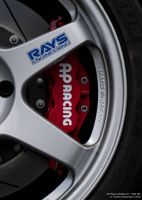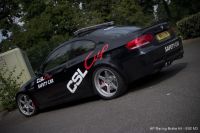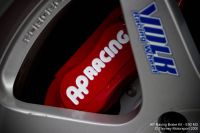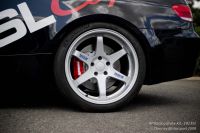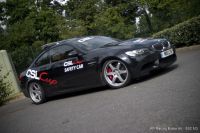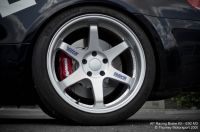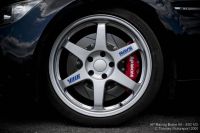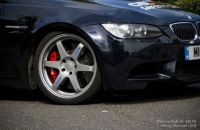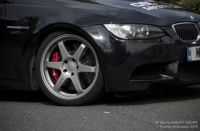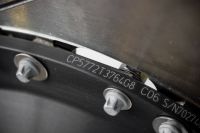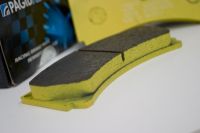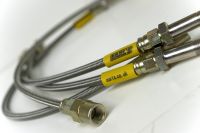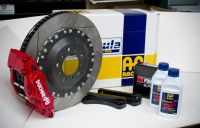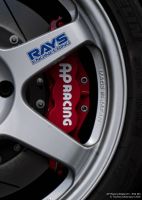By John Thorne – Wed, 12 Aug 2009 11:32
]]>
We love BMW; theycreate some of the greatest drivers cars on the planet. Cleverly styled,impressively engineered, expertly marketed and perfectly packaged as theultimate drivers machine. So why on Earth can’t they provide an M sport carwith a decent set of brakes? I shouldn’t complain of course, without BMWfumbling the ball on brake set ups on M3’s then companies like ThorneyMotorsport might not be as successful. Their failure is our gain, but even withthis it still stuns me to this day that there’s not been an M3 for over tenyears that had a braking system worthy of the M Sport badge. The E30 M3 wasgreat, but it weighed naff all so didn’t need decent brakes. The E36 was a stepcloser to cut price brakes but it was the E46 M3 that really won the award forthe crappiest brakes on a sports car award. How in the World BMW could justify a£40k car with a single sliding pot calliper is beyond me. Is the E92 M3 cutfrom the same cloth?
Well, no. The latestM3 is a lot better than its predecessor for brakes, the callipers are larger,the pads offer greater bite and overall the system is better than the previousmodel. However, the E92 is a lot larger and a lot heavier so the net result isstill the standard BMW offering – passable but not up to hard abuse on road ortrack, in short improved but still crap for a £50k car.
Before going throughthe options we’ve developed on brakes it’s probably a good idea to go into howthey work. Brakes are the perfectly example of wanting your cake and eating it,the fact you’ve bought a magazine called “Performance BMW’ I’m going to assumethat you know about how brakes work, disks passing through a calliper on thewheel yada yada but the overall issue with brakes is that they work bygenerating friction, friction is a good thing as that’s what causes the car toslow down, however friction generates heat and heat effectively acts againstthe efficiency of friction so you effectively have a vicious circle –
Braking = friction =increase heat = less braking.
What we do inupgrading brakes on cars is try to maximise friction whilst at the same timeminimising heat, as the Meercats would say ‘simples’.
To identify how toimprove braking we need to break (geddit?) down the system, brakes are made upof:
Disc (or Rotor for ourAmerican cousins) – this is the big round bit mounted to the hub
Calliper – the bigmetal bit that sandwiches the disk that holds
Pads – the actual bitsof metal that contact the disk
Hoses – these containthe hydraulic fluid that move the pistons in the calliper when you press thepedal
Master Cylinder –Regulates the amount of fluid and pressure in the system
ABS – The computerthat controls the anti lock braking system in conjunction with the brakesthemselves.
You – the driver, ashow you drive and use the brakes will have a direct effect on how good theyare.
The first port of callfor brake upgrades is the pads, the cheapest, simplest most direct way toimprove braking on any car. The ideawith pad changes is that the higher temperature tolerance of the differentmaterials means the brakes maintain their operating efficiency at highertemperatures, ie use them more and get them hotter and they still work as well.Standard pads on the M3 aren’t awful, compare them to Porsche and they are stillwoeful but overall they aren’t too bad in general driving, but press on a bitand pretty soon the pedal will feel softer and you’ll notice that brakingdistances will increase, sometimes dramatically, especially on track. There arenumerous brake pad suppliers around, all will tell you that their offerings arebetter than the rest with sintered this and metal matrix that but the only wayto really tell which is best is to test them. Thus far we’ve tested two typesfrom Pagid – RS421 and RS29. The RS421 pad (also known as Pagid Blue) is anuprated road pad, good for road use and should be seen as a better option tostandard, limited brake dust, limited squeal but still not really up to anytrack work without getting too hot (remember heat is bad). The RS29 (PagidYellow) is a full race pad, much harder with higher heat tolerance, we’ve beenusing these on the Safety Car duties, downside is more squeal when the car isused in town driving (goes away when you get them hot again), both work wellwith the standard disks. We’re still testing more pads but these two certainlystick out as the best so far.
Next up on the upgradepath are hoses. Brakes are a hydraulic system, ie its controlled by theexpansion and contraction of a fixed amount of hydraulic fluid in a sealedvolume. As with any hydraulic system the more it moves the greater the increasein fluid temperature. Remembering of course, heat is bad (getting bored of thatyet). With standard rubber hoses the outer casing are prone to expansion andtherefore increasing heat of the fluid so replacing these hoses with strongeritems that flex less will help. Goodridge and Earls have both developed braidedhoses for the E92, the effect is not dramatic in terms of power and is moreabout braking feel but it’s a nice upgrade and sensible as part of largerchanges. Changing the fluid is also a good idea, brake fluid is hydroscopic(absorbs water from the atmosphere) so does degrade over time, get the brakeshot or even boiling the fluid will cause the brake fluid to degrade faster andlessen its efficiency, we’d recommend to replace brake fluid more regularlythan the BMW schedule, especially if driving on track.
So, you’ve triedbetter pads, you’ve tried better hoses but still not enough? Not surprising,the E92 is a big old lump and we’ve found that for spirited driving or any realtime on track pads and hoses are not going to cut it so now we get to the realupgrade options – brake kits.
Brake kits are as theysound, complete system upgrades to improve every aspect of the braking systemfrom top to bottom. Typically the only things they don’t change (or affect) isthe master cylinder and the ABS control, everything else is up rated. There arethree or four decent manufacturers on brakes for the M3, Alcon (installed onthe CSL Cup race cars, the E46 M3 and CSL), AP Racing, Brembo and Stoptech toname a few. We have a long history with AP Racing, we’ve developed several kitswith them and they are one of the few companies with a very professional viewon product development so we were delighted when they called us about their newkit for the E92. Some R&D was needed both in fit and application so theSafety Car role for the CSL Cup for our car made perfect sense as a testvehicle.
Before going into thedetails of what the AP kits comprise its worthwhile going through each area ofbraking performance. The two main ways to improve braking performance are thereduction or increased dissipation of heat together with maximising thepad/disk interface, in other words – larger disks combined with larger pads.The AP kit increases the size of the disk to 378mm at the front and 350mm atthe rear. Perhaps more importantly, disc width is increased to 36mm at thefront and 26mm at the rear. This increase in width together with cleverlydesigned ‘vanes’ inside the disk are what allow the disk to cool faster than asolid or narrower disk, keeping cool = better brakes. There are two types offront kit available for those with 18” or 19” Wheels; the discs on the 18” are10mm smaller in diameter. The discs are grooved to keep the pad surface clear(not as some people think to keep the disk cool). The pad size is increased by60% over the standard pad so combined with the larger disk the overall pad/diskinterface is over 200% larger than standard. The discs (both front and rear)are separately mounted from the hub fixings on an aluminium bell, aluminium tosave weight but primarily to avoid the heat from the disk affecting theperformance of the hub and vice versa, separate belled disks are a crucial partof any brake upgrade. Finally there are the callipers, which are frankly, hugewhen compared to standard. The front kit has 3 pistons on each side (so isknown as a 6-piston calliper, also known as 6 pot) and the rear has a 4-pistoncalliper (4 pot). These pistons are variable in size to allow the pad tocontact with the disk in a progressivemanner, having the pistons the same size can mean the brakes have limitedmodulation and become on/off switches – not a good idea.
So, enough with thetechnical detail – what are they like? Bloody amazing is the answer. MiltonKeynes is one of the best places to test cars for brakes and handling (we loveroundabouts) and the improvement in braking generally is a revelation, smoothprogressive use generates no fade whatsoever and braking can be left later andlater with complete confidence. Aggressive braking manoeuvres come down to howbrave you feel such is the huge increase in confidence they offer. Most impressive is the overall feel, itsalmost as you can feel the disk pass through the calliper in use, its verytactile in use and really connects you to the road, all this improves the carsfeel and confidence on what you can do with it. Torque balance is perfect(front and rear balance) and whilst there is always some dive at the front –you cant change the laws of physics the car brakes very level allowingextensive use of trail braking. Running the Ferodo DS2500 road pad (there is anoption to run RS29 pads) there is minimal brake dust and no squeal even afterextensive time in traffic, and in bad boy red they are hard to miss, especiallyunder the 19” Rays wheels.
On track theimprovement is even more impressive. The ability to stab the brakes to scrubspeed is nicely handled and full race pace running didn’t show any issueswhatsoever; it really is a very impressive set up.
Sadly all thisperformance does cost, the kits can only be fitted at a full front and rearupgrade and so together cost £4,513.50, but they really are worth it.
Next month it shouldbe some power upgrades, will be eye opening I promise you.
John
Thorney Motorsport on Facebook


